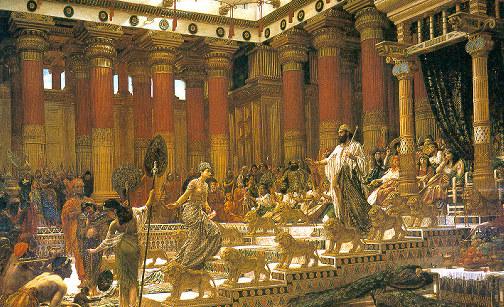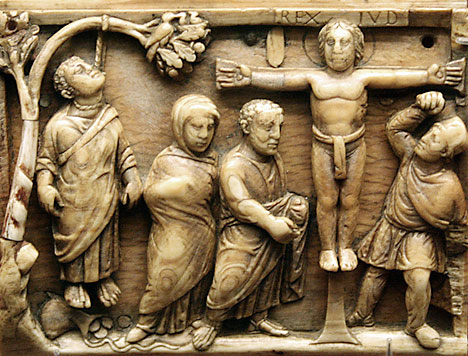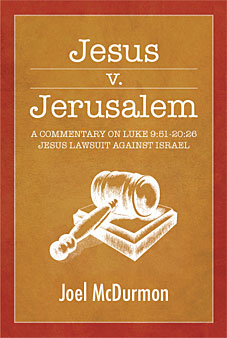Dec
4
2012

Read a very helpful introduction to the reasons for a preterist interpretation of the Revelation by Msgr. Charles Pope. HT: Micah Martin.
Currently in the Liturgies of daily Mass we have been reading the Book of Revelation. It is commonly read at the end of the liturgical year, for it bespeaks the end of, and passing qualities of all things of this world.
Continue reading
1 comment | tags: Hermeneutics, Preterism, Revelation | posted in Biblical Theology, The Last Days
Oct
31
2011
or The Cultic Core of Revelation

“Revelation is not just a vision of the King of Kings,
but of the King of Kings in His court.”
Preterists have a go at dispensationalists for interpreting the Bible through the lens of current headlines. We recognize that the Bible must be interpreted in its historical context, for its “first audience.” But there’s a brand of “newspaper exegesis” that plagues preterism as well.
Continue reading
Comments Off | tags: Dispensationalism, Ezekiel, James Jordan, Josephus, Kenneth Gentry, Moses, Preterism, Revelation, Tabernacle | posted in Biblical Theology, Quotes, The Last Days
Jul
14
2011

“…falling headlong, he burst open in the middle…”
Todd Robinson commented:
“I’ve enjoyed your particular brand of orthodox preterism. Working through Acts recently, I began to wonder what Michael Bull’s take on Acts 1:11 and 3:19-21 would be… Thanks for any insight.”
Continue reading
2 comments | tags: Abraham, Acts, AD70, Ascension, Atonement, Herod, Judas, Pentecost, Peter, Peter Leithart, Preterism, Urim and Thummim | posted in Against Hyperpreterism, Bible Matrix, Biblical Theology, The Last Days, The Restoration Era
May
13
2011
A Commentary on Luke 9:51-20:26
Jesus’ Lawsuit Against Israel
 .
.
I haven’t read this, but it sounds like an eye-opener for those new to preterism. Perhaps this approach will be helpful in getting Christians used to thinking more contextually about the New Testament:
“Most people don’t realize that many if not most of Jesus’ parables were intended not as general morality tales, but as particular pronouncements of coming judgment and change. Jesus was warning Jerusalem to repent and to accept its new King (Jesus) or else fall under ultimate condemnation of God.
Continue reading
4 comments | tags: Gary DeMar, Preterism | posted in The Last Days
Aug
28
2010
or Preterism is not a Dirty Word
 .
.
One thing that has struck me since becoming a preterist is how much evangelicals play down the badness of the baddies in the New Testament, i.e. the unbelieving Jews and Christian Judaisers.
Evangelicals would never believe that Jesus and the apostles were mistaken in their warnings of an imminent judgment (and let’s face it, this imminence is a facet of the New Testament that is inescapable). So the only other option they see as viable is a position that defies logic: an event that was near, at the doors, yet could happen at any time over next few millennia.
Continue reading
4 comments | tags: antichrist, Evangelicalism, Hermeneutics, John, Peter Leithart, Preterism | posted in Biblical Theology, The Last Days
Jul
29
2010

After reading (“orthodox”) preterists for a few years, the failure of modern evangelicals to read the New Testament in its historical context, and to understand its constant allusions to Old Testament event structures now floors me. How is it that we so easily underestimate the importance of the destruction of Judaism in AD70? And worse than that, how is it that we fail to understand that the imminent warnings of the apostles as prophets related to that event? Here’s a perfect example that hits both these ugly birds with one stone; some pure gold from Peter Leithart this week:
Continue reading
5 comments | tags: AD70, Church History, Evangelicalism, Peter Leithart, Postmillennialism, Preterism | posted in Against Hyperpreterism, Biblical Theology, The Last Days
Aug
24
2009
or Eclipsing the Temple of Doom
“Because narrow is the gate and difficult is the way which leads to life, and there are few who find it.” Matthew 7:14

Oh dear. This verse proves postmillennialism wrong. It also proves the rest of the Bible wrong because that is postmillennial too. Fortunately, this problem seems almost as simple to deal with as Irenaeus’ ambiguous text that non-preterists use to “unfound” preterism.[1]
Continue reading
1 comment | tags: Atonement, Bible Matrix, David Chilton, Feasts, Irenaeus, Kenneth Gentry, Postmillennialism, Preterism, Revelation, Sermon on the Mount | posted in Biblical Theology, Totus Christus
Aug
1
2009

“For as the new heavens and the new earth [Land] which I will make shall remain before Me,” says the LORD, “So shall your descendants and your name remain.” Isaiah 66:22
If you’ve been around preterism for a little while, you will know that this phrase is Covenantal. It refers to a new firmament (blood covering) and new mediators (on the Land); a new crystal sea government (Laver) and a restored four-cornered Israel (Bronze Altar).
So, Isaiah’s and Peter’s references to a new heaven and a new earth refer to looming Covenantal events, events which were contemporary to the respective authors. Isaiah spoke of the Restoration of Israel from Babylon. Peter spoke of the full inauguration of the kingdom in AD70.[1]
But extreme preterists want to divorce the term from physical reality altogether. I do follow them up to a point, but I think the solution is that, yes, all Creation is Covenantal, but it began with the physical world and will end with a restored physical world:
Continue reading
Comments Off | tags: AD70, Covenant Theology, David Chilton, Preterism, Tabernacle | posted in Biblical Theology, The Last Days
Apr
12
2009

The movie Superman Returns ends with some powerful iconography. Lex Luther has used a crystal stolen from Superman to create his own ‘new earth.’ Unlike Superman’s white-as-snow fortress of solitude, this is made of dark stone, Adamic earth. It rises up out of the sea and its growth threatens mankind.
Superman carries the weight of the entire sinful rock, and its growing kryptonite ‘spears’ pierce him. He ‘dies’ in the air and his fall to earth creates a ‘tomb.’ It’s worth a watch.
My point is, the idea of Christ being ‘lifted up’ is more than the bronze serpent, more than us ‘lifting Him up’ in our witness. [1]
Lifted up between heaven and earth, He was an open scroll. The bloodied lid of the Ark, the Word engraved (opened) on tablets of flesh. [2] In the sky, He was a new kapporet [3], a firmament covering to replace the old one that was ready to vanish away. He was a veil that was open, still protecting yet providing full access.
The Old Testament is full of mediators who are ‘lifted up.’ Revelation shows the Satanic new earth (Herod and Rome) thrown down from her mediatory position ‘in the air’, and the saints ascending to meet their Lord ‘in the air’ as a new mediatorial city.
a) Christ was lifted up.
b) Satan was thrown down.
a1) The saints of the New Jerusalem ascended.
b1) The compromised mediators were thrown down.
Satan is no longer the prince of the powers of the air.
__________________
[1] A Herod also fulfilled the bronze serpent image, eaten alive by maggots on his throne ‘in the air’ after speaking ‘like a god.’ He prefigured the dirty scavenging birds feasting on the harlot in Revelation.
[2] The Tabernacle layout is a symbolic cruciform man. Notice that Christ on the cross was beneath ‘the Name’, an open scroll containing the disputed truth of His identity. The Lord’s Name was said to dwell above the lid of the Ark.
[3] See Peter Leithart, The Footstool of His Feet.
Comments Off | tags: Add new tag, Ark of the Covenant, Covenant curse, Crucifixion, Film, Herod, Peter Leithart, Preterism, Tabernacle, Typology | posted in Biblical Theology, The Last Days


































